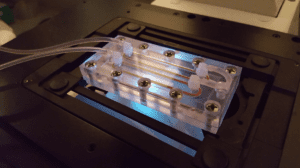New Technology Could Change How Mesothelioma Treatment is Monitored

New technology could eventually make it easier, less painful, and less expensive to track the progress of patients undergoing treatment for malignant mesothelioma and other cancers.
A research team led by University of Wisconsin-Madison pharmacy professor Seungpyo Hong has developed what they say is a more efficient method for capturing free-floating cancer cells in the blood.
The developers say the system is far more effective than existing systems at capturing these hard-to-find circulating tumor cells (CTCs) and could be used to supplement other technologies for tracking cancer treatment.
Mesothelioma Biopsy vs CTC Tracking
Although mesothelioma therapies have advanced in recent years, there is still no cure for the asbestos-linked cancer.
As scientists work to develop new kinds of treatments like targeted molecular therapies and immunotherapies, it is more important than ever for them to be able to track the effectiveness of mesothelioma treatment in real time.
In the past, this has meant obtaining multiple tumor samples, a process that can not only be uncomfortable and inconvenient for patients, but can also be expensive and subject to delays because of logistics. Depending on the location of the tumor, it can even be difficult or impossible to obtain a large enough tumor sample for testing.
CTCs Make Treatment Tracking Easier
Tracking CTCs with the technology developed by Dr. Hong and his collaborators represents a way to get around some of the limitations of biopsies for mesothelioma and other types of cancer.
According to a University of Wisconsin news release, the CapioCyte technology uses “sticky proteins” to slow the CTCs down as they move through the bloodstream, making it easier to catch them with cancer-specific antibodies.
In a new article published in Clinical Cancer Research, Dr. Hong and his team explain how cancer patients receiving radiotherapy were tracked throughout their treatment with the new technology. Dr. Hong says the actual number of circulating cancer cells in any one patient’s blood turned out to be less important than how that number changed.
“The more important thing we found was the trend—how the CTC numbers change over time upon treatment,” says Hong. “So, for example, we’ve shown that the CTCs go down when the patients are responding really well to the radiotherapy.”
Monitoring Mesothelioma with Blood-Based Biomarkers
Other types of blood-based biomarkers for tracking treatment progress in lung-related cancers like pleural mesothelioma include circulating tumor DNA (ctDNA), tumor derived exosomes, tumor educated platelets (TEPs), and microRNA.
Mesothelioma is an aggressive malignancy that typically occurs in people who lived or worked around asbestos in the past. It can take decades to develop but, once it does, most mesothelioma patients get sick very quickly, making fast, effective treatment planning and monitoring especially critical.
Sources:
Myung, et al, “Multivalent binding and biomimetic cell rolling improves the sensitivity and specificity of circulating tumor cell capture”, March 15, 2018, Clinical Cancer Research, Epub ahead of print
Hamilton, Eric, “Improved capture of cancer cells in blood could help track disease”, March 15, 2018
Mamdani, H, et al, “Blood-based tumor biomarkers in lung cancer for detection and treatment”, December 2017, Translational Lung Cancer Research, pp. 648-660





